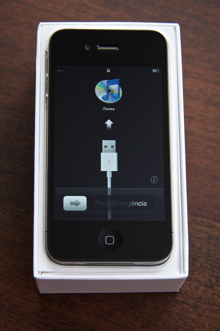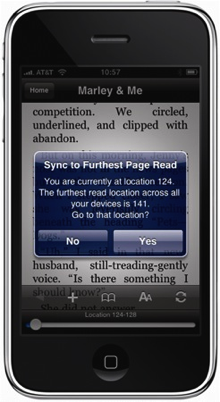
Opening up your shiny new Apple iDevice has always been a joy. Unfortunately that joy is dampened quite a lot by immediately having to connect the device to your computer with the supplied cable in order to activate it using iTunes.
Having to connect a brand new iPhone or iPad to a computer is one of the most jarring and archaic bits of the carefully crafted Apple experience left. It must drive Steve Jobs nuts.
Amid the buzz about the possibility of wireless over-the-air updates coming to the next version of Apple’s iOS software all I could think about was not having to connect a new device to the computer when you took it out of the box for the first time.
I have three computers in the home and I know that many users of iPhones and iPads have at least one in their households. But there is a whole segment of Apple customers that use iPhones and, to a greater extent, iPads that may not have a computer at all. My wife’s grandmother for instance has a computer, but it’s an ancient machine and does not have, nor can it probably run, iTunes properly. But she loves my iPad and wants one for herself.
Currently, instead of just ordering one, pulling it out of the box, powering it on and registering for an Apple account, she’s left with a black screen and a ‘connect to iTunes’ message.
This is the kind of glitchy user experience that we’re used to seeing from other companies, not Apple. Yet the Motorola Xoom, BlackBerry Playbook and even the Nook allow you to fire up the device, enter some info and away you go, using it in minutes. The inability for a user to unbox an iPod, iPad or iPhone and just use it is simply un-Apple.
Yet, it’s true that it only happens once and that you could conceivably use your iPad or iPhone without ever having to connect it to a computer again. But using them without a computer limits the ways that you can use them. You can stream video, download apps and browse the web, but you have no access to media like songs and videos on a local computer. Not to mention the fact that you’re stuck on the stock firmware that comes on the device without a way to upgrade it.
Wireless device activation
Apple’s cloud service could change all of this with the ability to synchronize your media to a media storage service, store your user information in the cloud and make transferring information between devices and computers seamless. It also adds the possibility of wireless device activation.
Currently the only reason that you have to connect any iDevice to your computer is to ensure that it is identified with an iTunes account. This enables the DRM protection for movies, books and apps and ensures that a user is set up to use that iTunes account to purchase more from the various stores.
It seems likely that Apple’s rumored iCloud service, something you could conceivably sign up for in any conventional browser ahead of time, will take a standard Apple ID. This would enable a new user to open the box, type in their login credentials and begin using the device, purchasing content from iTunes and updating their device when necessary. This kind of seamless ‘no computer required’ experience is much more along the lines of Apple’s philosophy. I have no doubt that it’s just that kind of experience that Jobs, who used the term ‘post-PC’ to describe the iPad 2, would be working towards with any cloud service.
The possibilities don’t just end with media storage, updates and device activation though. Saving application states across multiple devices is an absolute must-have for next-gen devices running with access to the cloud.
Seamless transfer of application states
So imagine that you’re editing that Pages document on your iPad over your morning coffee. Just when you get to a critical juncture in your edit, you have to set down your iPad and leave the house for your morning commute. Then, when you sit down on the bus you whip out your iPhone and continue editing the same document before you lose your thought. Seamless.
There are individual apps that do this already, the Kindle app being a prominent example. If you start reading a book in the app on your iPhone, then turn it off and pick up your iPad, you’ll be in the same place that you were on the iPhone. Amazon calls this Whispersync and it’s actually available cross-platform to Kindle hardware and software as well. It’s a killer feature and one that I don’t think Apple can afford not to imitate.
Instead of something done at the app level like Whispersync though, this integration should be at the OS level. Apple could then provide API’s for developers to allow their apps to access the syncing service, shoving state information up to the cloud and then allowing that information to be downloaded by your other iDevices from the same spot.
This way document states, game saves, photo edits and more would be available across all of your devices without any cabled syncing.
Post-PC
At this point it’s clear that we’re going to be seeing something to do with the way that iOS 5 will integrate cloud services at WWDC. In April, Apple placed an order for 12 petabytes worth of storage systems from Isilon, that’s enough space to store 160 years worth of HD video. Or perhaps enough space to store 45 million users worth of cloud syncing data.
In addition, a MobileMe migration service called Castle was discovered in the beta version of OS X Lion by French blog Consomac. Why would you include a migration tool without something else to migrate to? None of this evidence is hurt by the fact that Apple just finished work on a 500,000 square foot data center in North Carolina and has posted a job listing for people interested in creating “the future of cloud services at Apple.”
An iPhone or iPad that you can pull out of the box and use immediately, with all of your personal data and media at your fingertips having never touched a cable. This lack of need for a traditional computer brings a whole new meaning to the term ‘post-PC’.
Get the TNW newsletter
Get the most important tech news in your inbox each week.